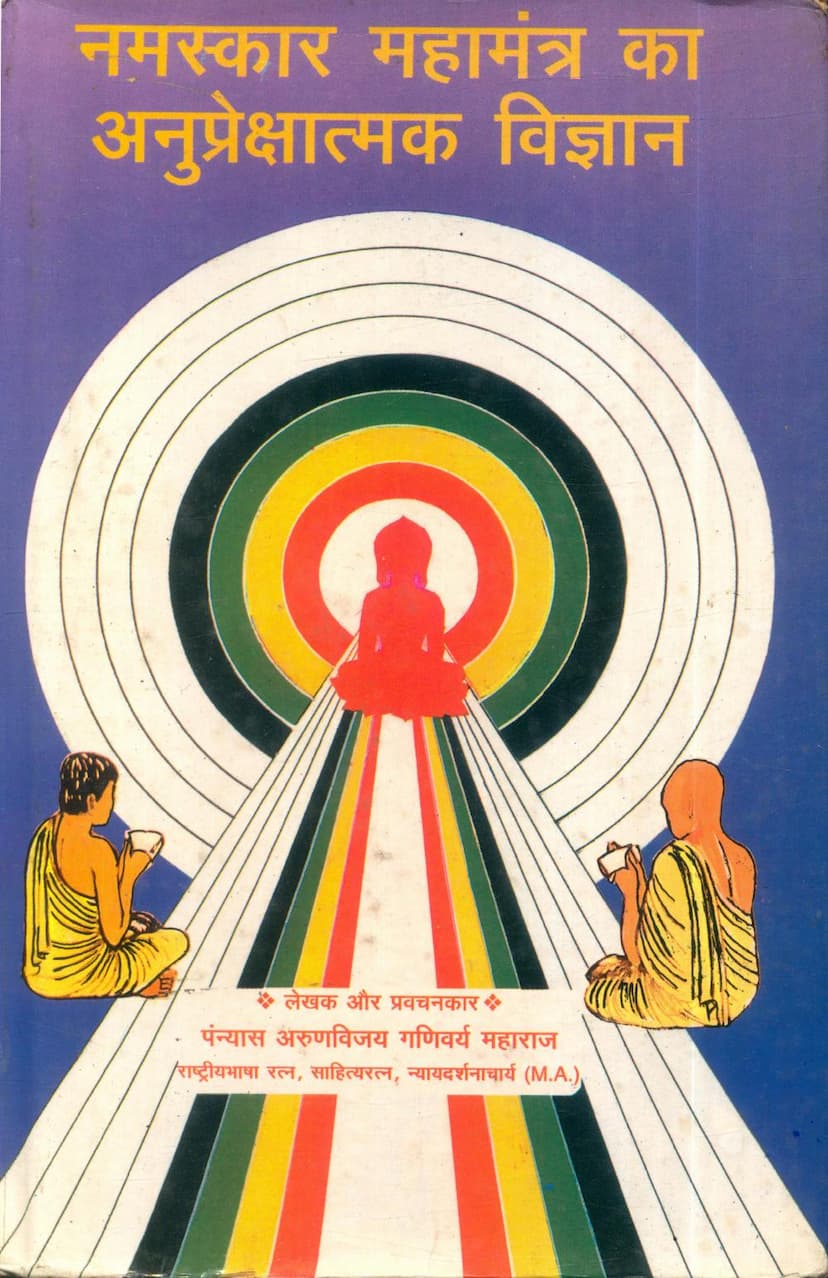Namaskar Mahamantra Ka Anuprekshatmak Vigyan
Added to library: September 2, 2025

Summary
This document is the table of contents and preliminary pages for the Jain text "Namaskar Mahamantra Ka Anuprekshat'mak Vigyan" (The Observational Science of the Namaskar Great Mantra) by Arunvijay. The book is published by Mahavir Research Foundation.
Here's a breakdown of the provided pages:
- Page 1: Title page with the book's title and author's name and credentials.
- Page 2: Detailed biography of the author, Panyas Arunvijay Ganivarya Maharaj. It highlights his renunciation at a young age, his academic achievements (Rashtrabhasha Ratna, Sahitya Ratna, Nyay Darshanacharya), his extensive travels and lectures across India, his role in the renovation of the Hathundi Rata Mahavir Swami Tirth, and his discipleship under prominent Jain Acharyas. It also mentions his talent for teaching with visual aids and his expertise in Jain Agamas and Sanskrit.
- Page 3: Publisher's information: Shri Mahavir Research Foundation, located in Pune, Maharashtra.
- Page 4: Book details: Title, author, translator (Shri Jasrajji Singhi), proofreader (Munishri Hemantvijay Maharaj), subject ("The Nature of the Arihant State"), financial supporter (Lunawa Jain Sangha), publisher, typesetting, printer, publication details (first edition, 1000 copies, Veer Samvat 2524 / V.S. 2054 / 1998 CE), price, and availability points.
- Page 5: Dedication page, offering the book to the author's revered Gurus, Acharya Dev Shrimad Vijay Premsurishwarji Maharaj Saheb and Acharya Dev Shrimad Vijay Subodhsuriji M. Sa.
- Page 6: Acknowledgment of financial support from the Shri Lunawa Jain Sangh and Shri Padmaprabh-Aadishwar Jain Devsthan Pedhi, Lunawa, Rajasthan.
- Page 7: Table of Contents, outlining the various chapters and their corresponding pages:
- The Philosophy of Navkar (Introduction)
- A Praiseworthy Chaturmas
- Author's Inner Thoughts
- Publisher's Heartfelt Words
- The Nature of the Namaskar Mahamantra
- The Necessity of 'Namo'
- The Nature of Creation and Theism
- A Review of the Creator God
- The Pure Nature of Arihant Parmatma
- The Immaculate Nature of Arihant Parmatma
- Page 8 - 14: These pages contain the Introduction ("The Philosophy of Navkar"), discussing the nature of mantras, their purpose, the prevailing eras of mantras, tantras, and yantras, and the importance of spiritual mantras for mental peace. It critically examines the concept of God as a creator and giver of happiness and suffering, attributing these to one's own karma. The author emphasizes the need for correct knowledge (Samyak Gyan) to develop true faith (Samyak Shraddha) and warns against blind faith. The text argues that true understanding of God reveals that the concept of 'will' or 'desire' is absent in the true divine nature, and questioning the inherent contradictory nature of such a concept. The author aims to guide the reader towards understanding the true nature of God through logical reasoning and intellectual appeal. The author's intention is to dispel ignorance and blind faith, leading readers towards attaining and becoming an Arihant.
- Page 14-17: Describe a specific "Praiseworthy Chaturmas" held in the Lunawa Jain Sangh, Rajasthan. It details the author's lectures on the Navkar Mahamantra, spiritual observances (68 fasts), charitable activities, and community events. It also mentions the spiritual community's contribution to the "Viraalayam" project in Pune. The pages highlight the spiritual atmosphere and the devotees' dedication during the Chaturmas.
- Page 17-18: "Author's Inner Thoughts" and "Publisher's Heartfelt Words". The author reflects on the philosophical depth of the Namaskar Mahamantra and his journey in exploring it. The publisher introduces "Shri Mahavir Research Foundation - Veeraalayam" as an institution dedicated to the study and publication of Jain scriptures, emphasizing their commitment to disseminating spiritual knowledge.
- Page 19-43: These pages are dedicated to the initial chapters of the book, starting with "The Nature of the Namaskar Mahamantra." It delves into the pervasiveness of the mantra across Jain scriptures, comparing it to the omnipresence of oil in sesame seeds, nectar in lotuses, and the five astikayas in the universe. The text explains that the Navkar Mantra is the essence of the 14 Purvas and all other Agamas. It describes the immense size of the 14 Purvas, highlighting their textual weight measured in elephants of ink. The text further discusses the classification of knowledge, the importance of Shrut Gyan (scriptural knowledge) over Keval Gyan in practical terms for spiritual progress, and the scientific and philosophical underpinnings of the Navkar Mahamantra. It touches upon the concepts of mantra, tantra, and yantra, and how the Navkar mantra holds a unique position, transcending mere ritualistic practices to encompass profound spiritual understanding. The text emphasizes the importance of understanding the meaning and philosophy behind the mantra, rather than just reciting it. It then elaborates on the significance of "Namo" as a fundamental principle, the critique of theism and the concept of a creator God, and the pure nature of the Arihant.
The subsequent pages (from page 8 onwards) seem to be the actual content of the book, discussing the philosophy, meaning, and significance of the Namaskar Mahamantra, its components, and its relevance to spiritual development, the concept of Arihant, and the broader principles of Jainism.
The provided text gives a glimpse into the author's profound understanding and the comprehensive nature of his exploration of the Namaskar Mahamantra.